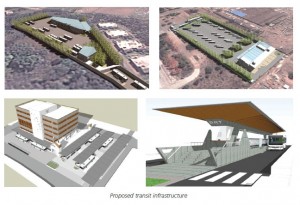Converting geographical challenges into opportunities
Junction design is a critical element of BRT design to avoid traffic delays and congestion. Conflict resolution and safe movement of all vehicles and pedestrians are crucial. For buses, priority is essential. An Area Traffic Control System would be installed along the corridor. This would enable all signals in the same direction along the corridor to be synchronized.
Out of the identified 43 junctions, six junctions are grade separated. This is done by designing four vehicle underpasses / BRTS bridges at these locations. These locations have been identified by assessing the existing road profile. Wherever the profile is undulating, the BRT corridor spans the ‘valley’. The intersecting road crosses through an underpass. The section below illustrates the concept. BRT infrastructure will be segregated on these structures. The proposed cross section is shown below.
Complete transit infrastructure transformation
A transit facility is a building/space that enables commuters to make a passage/ journey from one place to another. These are also places where vehicle parking and maintenance is done. The different transit facilities include bus stations, terminals, interchange stations, depots and workshops.
The proposed plan incorporates two BRTS terminals, two city bus and suburban service terminals and one regional terminal, two BRTS depots; one depot for city buses & another for central workshop.
Last mile connectivity
 This proposal includes providing high quality pedestrian infrastructure near all terminals, interchanges and important bus stations. It will focus on disabled friendly elements, comfortable walking environment for all and enhanced quality of life. It will feature use of paver blocks, street furniture, road signages, dust bins, lane markings, designated parking etc. It is proposed that in the first phase, all streets falling in a radius of 1km around major transit facilities will be upgraded. Overall, 58km of streets have been selected in Hubli, Dharwad and Navanagar as last mile connectivity network.
This proposal includes providing high quality pedestrian infrastructure near all terminals, interchanges and important bus stations. It will focus on disabled friendly elements, comfortable walking environment for all and enhanced quality of life. It will feature use of paver blocks, street furniture, road signages, dust bins, lane markings, designated parking etc. It is proposed that in the first phase, all streets falling in a radius of 1km around major transit facilities will be upgraded. Overall, 58km of streets have been selected in Hubli, Dharwad and Navanagar as last mile connectivity network.
Any BRTS requires support transit facilities for its efficiency. Hubli- Dharwad BRTS is planned together as an integrated facility with urban bus services of Hubli & Dharwad. The terminals and interchange facility are planned across the network to rationalize the operational efficiency as well as to provide passenger convenience.
BRTS Hubli-Dharwad has been proposed to provide convenient and quality public transit service for local residents. Therefore the supporting infrastructure is designed to provide efficient transit system. The overall strategy focuses on:
- Optimizing land resource
- Reducing traffic congestion
- Reducing dead kilometres
- Sharing common infrastructure
- Improving level of service for commuters and locals
- Maximizing efficiency over operation & management
in Urban Transport, CEPT University,
Ahmedabad.
Acknowledgement: Ahmedabad
Municipal Corporation & Ahmedabad
Janmarg ltd, Surat Municipal Corporation
& Sitilink Ltd, Directorate of Urban Land
Transport (DULT) and Hubli-Dharwad
BRTS Company Ltd.
 TrafficInfraTech Magazine Linking People Places & Progress
TrafficInfraTech Magazine Linking People Places & Progress